Biological Classification of Living Organisms Notes Study Material
Classification of Living Organisms Notes Study Material: At gurujistudy.com you can easily get all these study material and notes for free. In short, if you are a Biology Student there is a single-stop destination as far as preparation of Biology Examination is a concern. Here in this post, we are happy to provide you Chapter Wise / Topic wise Elementary Biology Biological Classification of Living Organisms Books Notes Study Material.

Biological Classification of Living Organisms Books Notes Study Material
Biological classification is the scientific procedure of arranging organisms into groups and subgroups on the basis of their similarities and dissimilarities and placing the groups in a hierarchy of categories. (Biological Classification of Living Organisms Notes Study Material)
NEED FOR CLASSIFICATION
A proper system of classification is a must because of the following reasons.
(1) It is not possible to study every organism. The study of one or two organisms of a group gives sufficient information about the essential features of the group.
(2) Without any system of classification organisms cannot be identified.
(3) Call types of organisms do not occur in one locality.
(4) The organisms of the past cannot be studied without a proper system of classification.
(5) Classification helps in knowing the relationships amongst different groups of organisms.
(6) On the basis of relationship and simplicity or complexity found in the members of various taxa, evolutionary tendencies can be known.
Objectives of Classification
(i) To identify and describe all the possible types of species.
(ii) To arrange the species in various categories on the basis of their similarities and dissimilarities.
(iii) To evolve a truely natural or phylogenetic system this should indicate origin and evolution of the species.
(iv) Helping in easy identification of organisms.
Types. There are three main types of classification– artificial, natural and phylogenetic.
Artificial System of Classification
It is a system of classification which uses one or two morphological characters for grouping of organisms. Some artificial systems have used habit and habitat for this purpose. Aristotle (c 350 BC) divided animals into two categories, enaima (with red blood) and anaima (without red blood). Aristotle also classified animals on the basis of their habitataquatic (e.g., fish, whale), terrestrial (e.g., reptiles, cattle) and aerial (e.g., birds, bat). Pliny the Elder (23–79 A.D.) used artificial system of classification for both plants and animals dividing them into land, air and water.
Pliny distinguished animals into flight and non-flight ones. Flight animals included bats, birds and insects. Linnaeus also put forward an artificial system of plant classification on the basis of numerical strength of sex organs into 24 classes like monandria, diandria, polyandria, didynamia, monoecia, cryptogamia, etc. Artificials system is easier to practise in the field. But it has several drawbacks like:
(1) It does not study homology but is mostly based on convergence.
(2) The system employs one or two morphological and ecological traits which have no bearing on the actual status of taxa.
(3) The characters picked up for artificial system of classification, show progressive, retrogressive or parallel evolution. Therefore, they do not reflect any natural relationship. (Biological Classification of Living Organisms Notes Study Material)
(4) Organisms do not show a clear cut evolutionary line. In some characters they may be more advanced than their relatives while in others they may be primitive. (Biological Classification of Living Organisms Notes Study Material)
(5) Organisms of different affinities get arranged in the same group like birds, bats and insects in flight animals or cacti, euphorbias and halophytes among succulent plants. Linnaeus’ monandria includes both dicots and monocots while his didynamia has both labiatae as well as gymnosperms.
(6) Some characters used in artificial system of classification get changed with change in environment like biennial and annual habit of radish, large and small leaves. (Biological Classification of Living Organisms Notes Study Material)
(7) The system does not give any idea about natural relationships amongst different taxa.
Natural System of Classification
It is a system of classification which takes into consideration comparable study of a number of characters so as to bring out natural similarities and dissimilarities and hence natural relationships among the organisms. The system employs those characters which are relatively constant. They include morphological characters, anatomical characters, cytological characters, physiology, ontogeny or development, reproduction, cytochemistry and biochemistry, experimental taxonomy, etc.
The characteristics are helpful in bringing out maximum number of similarities in a group and comparable differences with other groups of organisms. For example, mammals are characterised by the presence of mammae, hair, vivipary, 4-chambered heart, denucleated erythrocytes and warm blooded nature. Birds possess wings, feathers, pneumatic bones, ovipary, 4-chambered heart, nucleated erythrocytes and warm-blooded nature. Similarly, fishes do not possess limbs but fins. Their body is covered with scales. Respiration is through gills. Heart is two-chambered. They are coldblooded. (Biological Classification of Living Organisms Notes Study Material)
In natural system of classification, homology is brought out through the study of internal and external characters. Homology is the relationship of comparable structures having been derived from a common form. For example, the fore arm of different land vertebrates has the same pentadactyl constitution. It is externally much different in different organisms to perform different functions like grasping in human beings, running in horse, swimming in whale, flight in bird or a bat. Homology shows how each organ or structure has evolved in different groups to suit different functions.
Homology is studied in case of biochemicals as well. Molecular homology is the finding of relationship of comparable molecules like DNA, RNA and proteins by studying their similarities and dissimilarities. Even certain biochemicals occur in specific groups, e.g., betacyanin is found in beet root and related plants. The branch of biology that utilizes the study of chemicals in classification is called chemotaxonomy. Chromosomes or karyotypes are also important for knowing natural relationships. (Biological Classification of Living Organisms Notes Study Material)
In the nineteenth century many comparative studies were not available. Scientists relied more upon morphological and anatomical characters than other characters. A natural system for classification of seed plants was proposed by Bentham and Hooker (1862-1883) in their three-volumes treatise ‘Genera Plantarum’. These days a natural system of classification not only brings out natural relationships but also studies the evolutionary tendencies and phylogency with the help of all the available data including fossils. (Biological Classification of Living Organisms Notes Study Material)
Nature system of classification is certainly better than any artificial system of classification because
(a) There is stress on actual study of each and every organism.
(b) There is stress on comparative study.
(c) It brings about affinities on the basis of a number of characters.
(d) It brings out natural relationships amongst organisms.
(e) It places only related organisms in a group.
(f) The system prevents coming together of unrelated organisms.
(g) The system indicates phylogenetic relationships and the origin of different taxa.
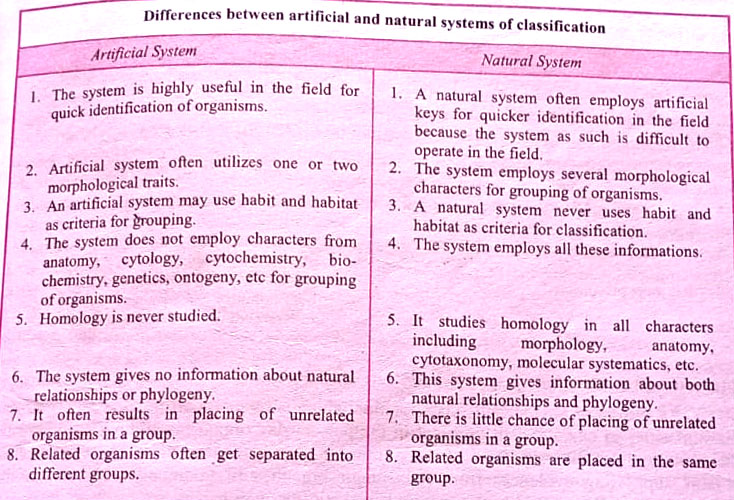
Phylogenetic System of Classification
Classification based on evolutionary relationships of organisms is called phylogenetic system of classification. It is based on the evolutionary concept from Darwin’s book- On the Origin of species by Means of Natural Selection: The Preservation of Favoured Races in the Struggle for Life (1859). It reflects the true relationships among the organisms. First phylogenetic system was proposed by Engler and Prantl (1887-99). In their treatise ‘Die Naturlichen Pflanzen Familien’ Engler and Prantl arranged flowering plants according to increasing complexity of their floral morphology.
They considered absence of perianth or presence of one whorl of perianth, unisexual flowers and anemophily primitive to flowers with two whorls of perianth, bisexual flowers and entomophily respectively. Monocots were considered primitive to dicots. However, achlamydeous and monochlamydeous conditions can develop through retrogressive evolution from dichlamydeous condition.
Their treatment of Asteraceae amongst dicots and Orchidaceae amongst monocots to be most advanced is correct. The major drawback of the system is that it considered evolution of angiosperm from a single stock (monophyletic origin). Improved phylogenetic systems were later proposed by Hutchinson (1959) and Takhtajan (1966). (Biological Classification of Living Organisms Notes Study Material)
However, a phylogenetic system is not static but highly dynamic. Its major source is fossil record. The same, however, is never complete due to difficulty in formation, exposure, discovery and study of fossils. As newer fossils are discovered, newer relationships are observed and consequently, phylogenetic system is changed and updated. Botanists and zoologists, however, differ in their concept of phylogenetic system.
Zoologists believe that since similarity in structure represents close evolutionary relationship, their natural classification represents evolutionary and phylogenetic classification.
Botanists do not believe in the same. They have noticed innumerable differences in the evolutionary trends of plants. A single genus of higher plants shows several advanced and primitive characters. It may resemble two or more families in its different characters. This is true because evolution does not mean unidirectional development in all the characters. Variations appear in different degrees in different traits. The selection process depends upon environment and competition. As a result a phylogenetic system can at best be partly evolutionary and partly numerical in its nature.

Phenetic Classification (Gk. phainein, to appear)
It is a system of phylogenetic classification which is based on affinities, similarities and dissimilarities of characteristics present in the present day organisms without searching for the evolution and diversification of these traits in their fossil ancestors. The classification obtains supporting evidences from four major branches of taxonomy- cytotaxonomy, chemotaxonomy, numerical taxonomy and cladistic taxonomy.
- Cytotaxonomy. It is classification based on information provided by comparative cytological studies, number of chromosomes, structure and meiotic behaviour of chromosomes. It is known that fewer and larger chromosomes have been formed in many cases by fusion of smaller chromosomes. Herbaceous plants have larger chromosomes than those of woody plants. Naturally, herbaceous plants are more advanced than the woody plants. (Biological Classification of Living Organisms Notes Study Material)
In many genera the same basic chromosome number has been found in different species, e.g. 12 in Solanum species and 9 in Chrysanthemum species. Human beings have 46 chromosomes while apes have 48. A reduction in number of chromosomes has been achieved through whole arm translocation between two acrocentric chromosomes. Apparently, humans have evolved from ape-like ancestors. Pairing of chromosomes during meiosis helps to bring out relationships between species. - Chemotaxonomy (Biochemical Systematics). The system of classification is based on characteristics of various chemical constituents of organisms like amino acids, proteins, DNA sequences, alkaloids, crystals, betacyanins, etc. Chemical constituents of plants are generally specific and stable. (Biological Classification of Living Organisms Notes Study Material)
They do not change easily. Ancient medical men based their identification of plants on fragrance, taste and other chemical characteristics. Crystals of calcium oxalate like raphides are restricted to 35 families. Similarly, certain alkaloids are restricted to a few related families, e.g., benzylisoquinoline alkaloid in Papaveraceae, Berberidaceae and Ranunculaceae. (Biological Classification of Living Organisms Notes Study Material)

- Numerical Taxonomy. It evaluates resemblances and differences or primitiveness and advancement through statistical methods based on a large number of characters obtained from all disciplines of biology. This is followed by assigning them number and codes of computer like plus (+), minus (-), e (data not available), followed by computer analysis. It establishes the numerical degree of relationship among individuals.
The relationship or affinity values are then used to erect taxonomic categories. However, its effectiveness depends upon the judgment of the biosystematist in selecting characters and current knowledge about them. - Cladistic Taxonomy (Gk. clados, sprout). It searches similarity due to common phylogeny or origin from a common ancestor. These are two types of characters, ancestral and derived. Ancestral characters are traits of basic body design which would be present in an entire group. Derived characters are those traits whose structures and functions differ from those of ancestral characters. They appear during evolution and cause the formation of new subgroups. (Biological Classification of Living Organisms Notes Study Material)
One or more derived characters would be shared by an entire subgroup. In cladistic taxonomy (cladistics) each evolutionary step produces a branching. All the members of a branch would possess the derived character. It will be absent below the branch point. Arranging organisms on the basis of their shared similar or derived characters, which differ from ancestral characters, will produce a phylogenetic tree called cladogram.
Depending upon the type of system of classification, organisms are classified into two kingdoms or three kingdoms, four kingdoms, five kingdoms and now into six kingdoms. (Biological Classification of Living Organisms Notes Study Material)
- Two Kingdom Classification (Before 1969)
In the past all the organisms had been divided into two groups, plants and animals, mainly on the basis of presence or absence of cell wall. This was also done by Linnaeus (the father of taxonomy). He founded two kingdoms- Kingdom Plantae and Kingdom Animalia.
The members of kingdom plantae are plants. They are distinguished by (i) presence of cell wall, (ii) occurrence of inorganic crystals in the cells, (iii) presence of central vacuole in the cell, (iv) absorption of inorganic nutrients from outside, (v) well defined growing points with unlimited growth, (vi) absence of excretory organs, sense organs and nervous system, (vii) ability to manufacture food due to presence of chlorophyll holophytic or autotrophic nutrition, (viii) reserve food as starch. (ix) occurrence of branches and less definite shape, (x) absence of locomotion, (xi) absence of muscular tissue, (xii) presence of external organs and (xiii) slow response to external stimuli.
Members of kingdom animalia possess the opposite characters as (i) absence of cell wall, (ii) Inorganic crystals are not present in their cells, (iii) absence of central vacuole in the cell, (iv) ingestive (holozoic) type of nutrition, (v) well defined growing points absent, growth limited, (vi) presence of excretory organs, sense organs and nervous system, (vii) inability to manufacture food due to absence of chlorophyll, (vii) reserve food as glycogen, (ix) absence of branches and having definite shape, (x) presence of locomotion, (xi) muscular tissue present, (xii) organs internal and (xiii) quick response to external stimuli. (Biological Classification of Living Organisms Notes Study Material)
Several objections have been raised against this two kingdom classification. They are:
(i) First formed organisms were neither plants nor animals.
(ii) Fungi differ in the structure, physiology and reproductive details from plants,
(iii) At the lower level of organisation there are several instances where the distinction of plant and animal disappears. For example, Euglena has both holophytic and saprobic nutrition (mixotrophic nutrition). Its relatives have both holophytic and holozoic nutrition. Sponges, are branched, fixed and irregular in outline just like plants. Unicellular algae like Chlamydomonas are motile, possess regular shape, definite growth and photosensitive organelles. (Biological Classification of Living Organisms Notes Study Material)
(iv) Slime Moulds, a group of fungi, are wall-less in the vegetative phase when nutrition is holozoic. They develop cell walls in the reproductive phase. Slime moulds can neither be placed in fungi, nor plants. This group is popularly called an animal group which is studied by mycologists.
(v) Lichens constitute a peculiar group of dual organisms which are formed by an association between an alga and a fungus. They have no plant character, neither any animal character. (Biological Classification of Living Organisms Notes Study Material)
(vi) Viruses have a volume of 10-6 to 10-3 µm3. Procaryotes have a volume range of 0.2 to 10 cubic µm3 while the average eucaryotic cell has volume between 1000-10000 um3. All of them cannot occur in a single kingdom.
(vii) Procaryotes have a naked genetic material without being organised into a nucleus, a single envelope organisation, and absence of spindle apparatus, meiosis and sexual reproduction. Viruses have no protoplasm and metabolic machinery of their own. On the other hand, eucaryotes have a well defined nucleus, a double envelope organisation, spindle apparatus, meiosis and sexual reproduction. Therefore, the three must be separated from one another. (Biological Classification of Living Organisms Notes Study Material)
(viii) Groups of unicellular algae (euglenoids, diatoms and dinoflagellates) and protozoa show sufficient degree of resemblance.
- Three Kingdom Classification
Haeckel (1866) separated unicellular animals, algae and fungi from other organisms on the basis of lack of tissue differentiation. The new group was called kingdom protista. Later on fungi and multicellular algae were taken out from the group so that kingdom protista came to have only unicellular organisms divided into three kingdoms – Plantae, Protista and Animalia.
- Four Kingdom Classification
With the advent of electron microscope, it became clear that bacteria and related organisms have a different nuclear structure as compared to others. They are procaryotes in contrast to others which have a true nucleus and are called eucaryotes. Copeland (1956) created a separate kingdom of monera (=Mychota) for them. This divided the living world into four kingdoms- monera, protista, plantae and animals. In this system fungi continued to remain with the plantae. (Biological Classification of Living Organisms Notes Study Material)
- Five Kingdom Classification (from 1969 to 1990)
In order to develop phylogenetic classification, R.H. Whittaker (1969), an American taxonomist, divided all the organisms into live kingdoms. As the viruses are on the border line of living and nonliving they have been left out.
Whittaker has used five criteria for delimiting the different kingdoms. (i) Complexity of cell structure, prokaryotic and eukaryotic. (ii) Complexity of body structure or structural organisation, unicellular and multicellular. (iii) Mode of nutrition which is divergent in multicellular kingdoms- photoautotrophy in plantae, absorptive heterotrophy in fungi and ingestive heterotrophy in animalia. Photoautotrophic nutrition is also called holophytic nutrition while ingestive heterotrophy is known as holozoic nutrition. Absorptive heterotropy is saprobiotic (= saprophytic) nutrition. (iv) Ecological life style like producers (plantae), decomposers (fungi) and consumers (animalia). (v) Phylogenetic relationships.
Whittaker’s five kingdoms are Monera, Protista, Plantae, Fungi and Animalia
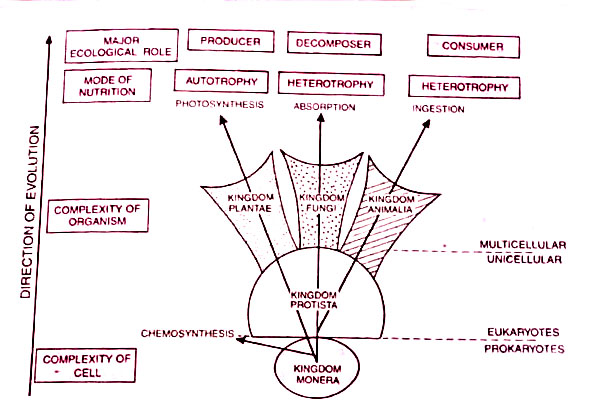
Monera– Kingdom of Procaryotes
The kingdom includes all procaryotes- mycoplasma, bacteria, actinomycetes and cyanobacteria or blue green algae. Alongwith fungi, they are decomposers and mineralisers of the biosphere.
(i) Monerans are basically unicellular (monos-single) procaryotes and contain the most primitive of living forms.
(ii) They are varied in their nutrition-saprobic, parasitic, chemoautotrophic, photoautotrophic and symbiotic. The photoautotrophs include both aerobes and anaerobes. (Biological Classification of Living Organisms Notes Study Material)
(iii) The cells are microscopic (0.1 to a few microns in length).
(iv) Cell Wall is generally present. It contains peptidoglycan and polysaccharides other than cellulose.
(v) Cells have one envelope type of organisation, i.e., the whole protoplast is covered by plasma membrane but internal compartmentalisation is absent. (Biological Classification of Living Organisms Notes Study Material)
(vi) Genetic material is not organised into a nucleus,
(vi) DNA is naked, i.e. it is not associated with histone proteins. DNA lies coiled inside the cytoplasm. The coiled mass is known as nucleoid. It is equivalent to a single chromosome.
(viii) All membrane bound cell organelles are absent, e.g., mitochondria, lysosomes, spherosomes, golgi bodies. plastids, etc.
(ix) The flagella, if present, are single stranded instead of being 11 stranded in eucaryotes. They are formed of protein called flagellin.
(x) Mitotic spindle is absent.
(xi) Gametes are absent. Gene recombination has been discovered in certain cases. Otherwise reproduction is by asexual methods.
(xii) Some of the monerans have the ability to convert dinitrogen into ammonia state.
Protista— Kingdom of Unicellular Eucaryotes
It is kingdom of unicellular eukaryotic organisms. Kingdom Protista has brought together Chlamydomonas, Chlorella (earlier placed in Algae within Plants and both having cell walls) with Paramoecium and Amoeba (which were earlier placed in the animal kingdom which lack cell wall.
Kingdom protista includes flagellates (euglenophyceae), diatoms, dinoflagellates, slime moulds, sarcodines, ciliates, sporozoans, etc.
The important characteristics are:
(i) It includes all unicellular and colonial eucaryotes.
(ii) Mostly they are aquatic organisms forming plankton.
(iii) They have diverse modes of nutrition – photosynthetic, saprobic, parasitic, ingestive, or holozoic etc.
(iv) The photosynthetic plankton are called phytoplankton. They usually possess cell wall and constitute an important group of producers. The non-photosynthetic, wall-less and holozoic plankton are called zooplankton. Holozoic nutrition involves ingestion of particulate food. The protistans having holozoic nutrition are collectively called protozoa, though they have been excluded from kingdom animalia.
(v) There is a group of Euglena-like organisms which have a dual mode of nutrition, holophytic or photosynthetic in light and holozoic in absence of light or presence of abundant organic matter. Slime moulds are a group of protista which are intermediate between wall-less and walled organisms. They are devoid of a wall in vegetative phase. In the vegetative phase, the nutrition is of ingestive type. In the reproductive phase, the slime moulds come to have cell walls. (Biological Classification of Living Organisms Notes Study Material)
(vi) The cellular organisation is of two envelope type, i.e., besides plasma membrane, internal membranes occur around certain organelles.
(vii) Genetic material is organised in the form of nucleus. DNA is associated with histone proteins.
(viii) The aerobic forms possess mitochondria. Endoplasmic reticulum, golgi bodies, lysosomes and centrioles occur.
(ix) Flagella, if present, are 11 stranded with 9 + 2 organisation of microtubules that are composed of a protein named tubulin.
(x) Both sexual and asexual modes of reproduction are 2 present. However, an embryo stage is absent.
(xi) Tissue system is, absent.
Kingdom protista does not seem to be a natural group due to (i) Dinoflagellates are F mesokaryotic and not eucaryotic. (ii) A distinction of unicellular protistan algae and green algae included in volvocales is not valid. (iii) Slime moulds are quite distinct from rest of the protists. (iv) There are several evolutionary lines in protista. (v) Protists of this kingdom have diverse modes of form, structure and life.
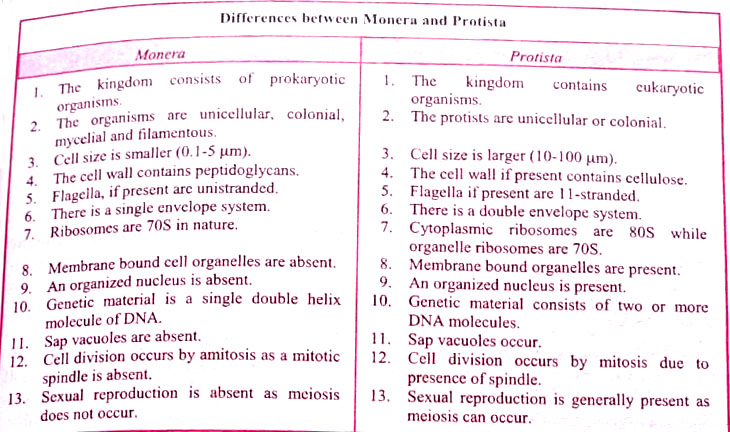
Fungi— Kingdom of Multicellular Decomposers
The kingdom includes moulds, mildews, yeasts, rust causing fungi, pencillium, morels, mushrooms. puff balls, bracket fungi, etc, i.e., all the fungi of the two kingdom classification except slime moulds. (Biological Classification of Living Organisms Notes Study Material)
(i) It contains achlorophyllous, spore producing, multicellular or multinucleate euckaryotic organisms. Basically unicellular yeasts are also included amongst fungi because their sexual reproduction is similar to that of some fungi.
(ii) The organisms are heterotrophic with absorptive type of nutrition. It is either saprobic or parasitic. Symbiotic association occurs with some algae and higher plants, e.g., lichens, mycorrhiza. The saprobic fungi excrete hydrolytic or digestive enzymes in the external medium for digesting complex organic compounds. The parasitic fungi absorb nourishment directly from another living organism called host.
(iii) The body of fungus is filamentous and is called mycelium. The filaments are known as hyphae.
(iv) Hyphae are either multicellular or multinucleate. Nuclei are very small and show intranuclear spindle.
(v) The wall contains chitin and noncellulosic polysaccharides. Cellulose also occurs in a few cases.
(vi) The cellular organisation is two envelope type.
(vii) In most cases, golgi bodies are unicisternal.
(viii) Reproduction is both asexual and sexual.
(ix) Vegetative body or mycelium is not clear externally in most of the cases due to its subterranean nature. Reproductive bodies, are, however, apparent as in mushrooms, toadstools, puff balls, bracket fungi.
(x) Tissue differentiation is absent.
(xi) Food reserve is glycogen and fat.
The kingdom is important in nutrient cycling because along with some protistans and monerans, fungi are decomposers and mineralisers of the biosphere. (Biological Classification of Living Organisms Notes Study Material)
Plantae – Kingdom of Multicellular Producers or Metaphyta
The kingdom contains all photosynthetic eucaryotic multicellular plants and their non-photosynthetic relatives. At the lower level it contains multicellular algae-green, brown. and red algae. Other groups included in the kingdom plantae are bryophytes, pteridophytes and spermatophytes.
Important characters of this kingdom are as follows:
(i) Organisms are multicellular.
(ii) They are eucaryotic.
(iii) Body form is less regular.
(iv) Growth is usually indefinite.
(vi) Organs are commonly external.
(vii) Irritability is poor.
(viii) Mode of nutrition is autotrophic.
(ix) The photosynthetic regions contain plastids in their cells. Due to photosynthetic activity, plants are called producers.
(x) Most of the plants are restricted to land, sea-shores and fresh water reserviors.
(xi) The plants are usually fixed or free floating. Active locomotion is generally absent.
(xii) Structural differentiation into tissues is found except for certain algae.
(xiii) Food reserve is usually starch and fat.
(xiv) Some of the plants are heterotrophic. They are mostly parasitic. A few are saprobes. A small group of autotrophic plants catch small animals and insects for obtaining extra nitrogen. They are called carnivorous or insectivorous plants.
(xv) Reproduction is both asexual and sexual. Accessory spores are present in lower plants. An embryo stage is absent in the algal group but is present in others. (Biological Classification of Living Organisms Notes Study Material)
Animalia – Kingdom of Multicellular Consumers or Metazoa
Members of this kingdom are also known as metazoa or multicellular animals. The kingdom has maximum number and most diverse types of organisms. It includes all the animals of the two kingdom classification except Protozoa. Groups included are sponges coelenterates, worms, molluscs, arthropods, star fishes and vertebrates like fishes, amphib. ians, reptiles, birds and mammals. Insects, a group of arthropods, outnumber all other organisms in variety and number.
The important characteristics of animalia are :
(i) Organisms are multicellular eucaryotes.
(ii) Body form is regular.
(iii) Organs are internal.
(iv) Growth is definite. Well defined growing points are absent.
(v) Cellular, tissue and organsystem levels of organisation occurs in different groups.
(vi) Response to stimuli is quick.
(vii) A cell does not possess central vacuole. Instead small vacuoles may occur.
(viii) Centrioles occur in the cells.
(ix) A cell wall is absent.
(x) Plastids and photosynthetic pigments are absent.
(xi) The organisms have holozoic or ingestive type of nutrition. A few animals are, however, parasitic. They live on or inside the bodies of other eucaryotes. (Biological Classification of Living Organisms Notes Study Material)
(xii) Animals are motile or mobile as they have to search for their food. Sponges and corals are an exception.
(xiii) The organisms possess muscle cells for their mobility and nerve cells for conduction of impulses. They are, however, absent in sponges.
(xiv) Reproduction is mostly sexual. Regeneration of whole organism and formation of spores are found in lower animals.
(xv) Embryo stage is present.
(xvi) Ecologically animals are consumers. These consumers constitute links in the food chains and food webs.
Advantages of Five Kingdom Classification
- Separation of prokaryotes in a separate kingdom of Monera is a wise step because procaryotes differ from all other organisms in their genetic, cellular, reproductive and physiological organisation. (Biological Classification of Living Organisms Notes Study Material)
- Many transitional or intermediate forms are present in the unicellular eucaryotes which had been included both amongst plants and animals. Separation of unicellular eucaryotes into kingdom protista has removed this anomaly.
- Fungi have never been related to plants. They have their own biochemical, physiological and structural organisation. Separation of fungi into a separate kingdom was long overdue. (Biological Classification of Living Organisms Notes Study Material)
- The five kingdom classification is based on levels of organisation and nutrition which evolved very early and became established in later groups that are existing today. (Biological Classification of Living Organisms Notes Study Material)
- In this classification, animal and plant kingdoms are more homogeneous than they are in two-kingdom classification.
- It has tried to bring out phylogenetic relationships even amongst the primitive forms.
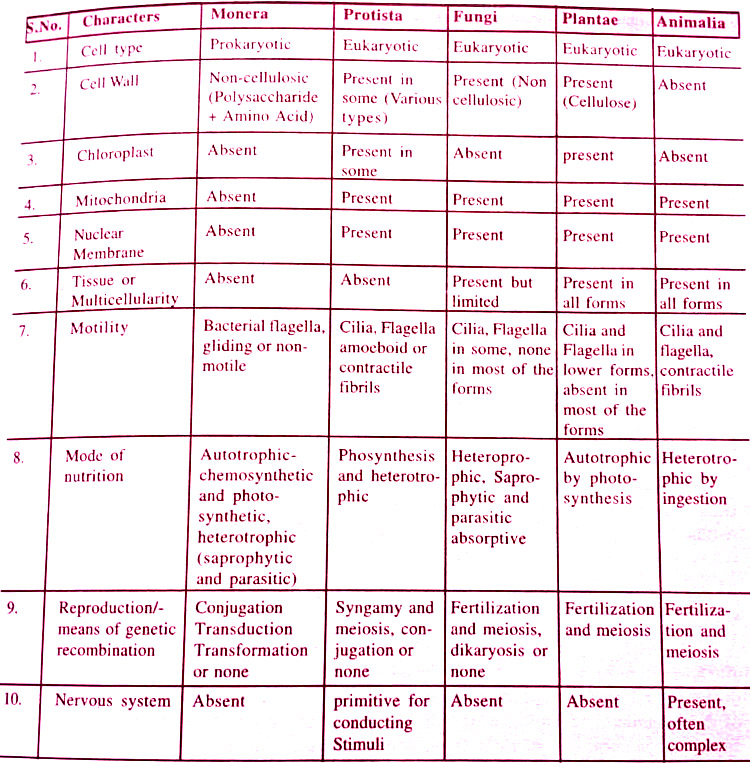
Drawbacks of Five Kingdom Classification
- In real terms the phylogenetic system cannot be established till all the distinct evolutionary tendencies are separated. This is not possible at the lower level. For example, certain green algae are known to obtain hydrogen from sources other than water like photosynthetic bacteria. Similarly, Euglena can be photosynthetic as well as saprotrophic. Its relatives can have absorptive as well as ingestive type of heterotrophic nutrition.
- A distinction between unicellular and multicellular organisms is not possible in case of algae. It is because of this that unicellular green algae have not been included in kingdom Protista by Whittaker. (Biological Classification of Living Organisms Notes Study Material)
- Each group has so many diversities that it is difficult to keep them together example, monera and protista contain both walled and wall-less organisms, photosynthetic and non-photosynthetic organisms, unicellular and filamentous or mycelial organisms.
- Viruses have not been included in this system of classification.
- Archaebacteria differ from other bacteria in structure, composition and physiology.
- Mycoplasmas are quite different from bacteria where they have been placed alongwith prokaryotes.
5. Three Domains of Life (Six Kingdom Classification) — 1990
The three-domain system is a biological classification which was introduced by Cari Woese, a professor in the Department of Microbiology, University of Illinois, Urbana-Champaign in 1990 that divides cellular life forms into archaea, bacteria and eukarya domains. It emphasizes the separation of prokaryotes into two groups, originally called Eubacteria (now Bacteria) and Archaebacteria (now Archaea).
Because of their fundamental differences, Woese argued that each of the two arose separately from an ancestor with poorly developed genetic machinery, often called a progenote. (Biological Classification of Living Organisms Notes Study Material)
Infact the three-domain system is loosely based on the traditional five-kingdom system but divides the Monera into two “domains”, leaving the remaining eukaryotic kingdoms in the third domain. (Biological Classification of Living Organisms Notes Study Material)
It is actually a six kingdom classification.
- Archaea Domain. The domain contains prokaryotic organisms which have a mono layer core of lipids in the cell membrane and distinct nucleotides in their 16S RNA. It contains a single kingdom.
Kingdom Archaebacteria. The kingdom contains early prokaryotes which live in extreme environments, e.g., (i) Methanogens- metabolize hydrogen and carbon dioxide into methane. (ii) Halophiles – live in salt. (iii) Thermoacidophiles – live in acid and high temperatures (upto 110 degrees Celsius). (Biological Classification of Living Organisms Notes Study Material)
- Bacteria Domain. The domain contains typical prokaryotes which lack membrane covered cell organelles but do have a sort of microchambers for separating various activities, There is a single kingdom. (Biological Classification of Living Organisms Notes Study Material)
Kingdom Eubacteria. The kingdom contains diverse types of bacteria having peptidoglycan cell wall, glycogen as food reserve, naked DNA coiled to form nucleoid, absence of sap vacuoles and presence of 70S ribosomes. Some common groups are bacteria, my. coplasma, actinomycetes, rickettsiae, spirochaetes, firmicutes, cyanobacteria. (Biological Classification of Living Organisms Notes Study Material)
- Eukarya Domain. The domain contains eukaryotic organisms which originated by endosymbiotic association between some archaebacteria and eubacteria. It has four king. doms – Protista, Fungi, Plantae and Animalia, (Biological Classification of Living Organisms Notes Study Material)
STATUS OF VIRUSES
Virus (L. poison) is a nucleoprotein entity which is able to utilize the synthetic machinery of a living cell of another organism for its multiplication which does not involve growth and division. Even before its discovery a lot of work had been done on virus. Small pox and polio are two viral diseases known since pre-historic times.
Broken Tulip (a symbol of love and nicety) was a product of viral infection which was transferable from one variety to another (Causius, 1576). Jenner (1796) discovered vaccination against small pox. Pasteur (1880) found rabies to be infectious disease and produced anti-rabies vaccine. He also coined the term virus before its scientific discovery. (Biological Classification of Living Organisms Notes Study Material)
Mosaic disease of Tobacco (Mayer, 1886) was found to be caused by a filterable agent present in the extract of diseased tobacco plant by Ivanowski (1892). He is credited with the discovery of virus, Beijerinck (1896) called it ‘contagium vivum fluidum’ (living infectious fluid). Virus was seen under light microscope by Takahashi and Rawlins (1933) and under electron microscope by Stanley (1946). Stanley (1935) crystallised Tobacco Mosaic Virus (TMV) for the first time. Nucleoprotein nature of virus was discovered by Bawden and Pirie (1936).
Polio virus was cultured for the first time in human cells by Enders (1949). Virus cannot grow on nonliving culture medium. It requires living cells for its ‘metabolism’ and multiplication. Hershey and Chase (1952) confirmed that DNA is genetic material in bacteriophages. Franklin Conrat (1956) and later Gierere and Schramm (1956) found RNA to be genetic material in Tobacco Mosaic Virus (TMV). Sinsheimer (1959) observed the presence of single stranded DNA in bacteriophage ϕ x 174. Retroviruses were discovered by Temin (1970).
Virus is obligate parasite. It is inert outside the host cell. An inert virus is called virion. It can be crystallised and stored indefinitely. A biosynthetic machinery is absent. There is no system to liberate energy. A virus does not grow. It does not divide or reproduce like typical organisms. Instead it multiplies by independent formation of its parts using host machinery and then assembly of parts to produce virus particles. A virus lacks irritability and motility. It requires a vector for transfer from one host to another. Virus having an arthropod as vector or intermediate host is called arbovirus.
Size. Virus is the smallest entity. Size varies from 10 nm (Foot and Mouth Virus of Cattle), 17 nm (Alfalfa Mosaic Virus), 300 x 17.5 nm (in TMV), 400 nm (Parrot Fever Virus), 1250x 40 nm (Beet Yellow Virus), 1300 x 6 nm (Pseudomonas Pf ).
Shape. Three architectural forms are found in viruses— helical (elongate body, e.g., TMV), cuboidal (short broad body with rhombic, rounded, polyhedral shape, e.g., Poliomyelitis virus) and binal (with both cuboidal and helical parts, e.g., many bacteriophages like T2).
Classification. Genetic material is either DNA or RNA. Accordingly viruses are divided into two groups: (a) Deoxyvira or DNA viruses. All the three structural forms are knowndeoxyhelica, deoxycubica and deoxybinala. (b) Ribovira or RNA viruses.
They are of two types, ribohelica and ribocubica. Most of the animal viruses are DNA viruses with a few important ones having RNA, e.g., Rabies Virus, Polio Virus, retroviruses including HIV or AIDS virus. Most of the plant viruses are RNA-viruses with a few having DNA (e.g., Cauliflower Mosaic Virus). Bacteriophages have commonly double stranded DNA but all other genome types also occur.
Types. Viruses are host specific. Holmes (1948) has divided viruses into three groups:
(a) Plant Viruses (Phytophagineae). They cause disease in plants, e.g., Tobacco Mosaic Virus; Potato Mosaic Viruses, Banana Bunchy Top Virus, Tomato Leaf Curl Virus. (Biological Classification of Living Organisms Notes Study Material)
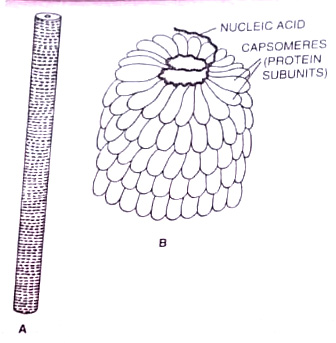
(b) Animal Viruses (Zoophagineae). They parasitise animals including human beings, e.g., Poliomyelitis Virus, Influenza Virus, Small Pox Virus, Hepatitis Virus, Mumps Virus, Rhino Viruses (common cold viruses). (Biological Classification of Living Organisms Notes Study Material)

(c) Phagineae. They parasitise lower organisms- bacteriophages (bacterial viruses, e.g., T2, T4, lambda), coliphages (bacteriophages of Escherichia coli), cyanophages (blue-green algal viruses, e.g., LPP-1, SM-1, N-1), phycophages (algal viruses), mycophages (fungal viruses), zymophages (mycophages of yeast). (Biological Classification of Living Organisms Notes Study Material)
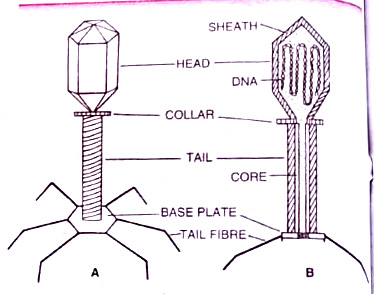
Components
A virus consists of two parts- nucleoid (genome) and capsid. An envelope is present in some cases. A few enzymes are also known to occur occasionally inside the virus.
- Nucleoid. It represents the viral chromosome. Nucleoid or viral chromosome is made of a single molecule of nucleic acid. It may be linear or circular with various degrees of coiling. Nucleoid is the infective part of virus. The nucleic acid is either DNA or RNA but never both. DNA containing viruses are called deoxyviruses while RNA-containing viruses are termed as riboviruses. Each of them has two subtypes, double stranded and single stranded. (Biological Classification of Living Organisms Notes Study Material)
(i) Double Stranded or dsDNA. It occurs in T2, T4, bacteriophages, coliphage Lambda, Cauliflower Mosaic, Pox Virus. Adenovirus, Herpes Virus (linear), Polyoma Virus, Simian Virus-40 (SM40), Hepatitis B (circular). (Biological Classification of Living Organisms Notes Study Material)
(ii) Single Stranded or ssDNA. Coliphage MS 2, Coliphage fd (linear), Coliphage ϕ X 174 (circular). The single strand of DNA is called plus strand. A complementary or negative strand DNA is synthesised to produce DNA duplex for replication during multiplication of Virus.
(iii) Double Stranded or dsRNA. It is found in Reovirus and Tumour Virus (both linear).
(iv) Single Stranded or ssRNA. The condition is more common in riboviruses. The single strand RNA is generally linear, e.g., Poliomyelitis Virus, Foot and Mouth disease Virus, Influenza Virus, Tobacco Mosaic Virus (TMV), Tobacco Necrosis Virus, Potato Mosaic Virus, Bean Mosaic Virus, Retroviruses. Retroviruses have two copies of single stranded RNA (hence diploid), e.g., HIV (Human Immunodeficiency Virus, HTLV-III, AIDS Virus), HTLV-1, HTLV-11 (Human T-lymphotrophic Viruses), Rous Sarcoma Virus (RSV of Mouse).
In some riboviruses, the RNA can directly function as template and take part in replication (e.g., TMV, Influenza Virus, Paramyxo Virus). In other riboviruses, the RNA of the nucleoid is first employed in synthesising complementary DNA through reverse transcription (e.g., Oncogenic Viruses, HIV). Because of the latter, these viruses are called retroviruses. (Biological Classification of Living Organisms Notes Study Material)
The viral chromosome or nucleoid does not contain many genes. T4 bacteriophage contains about 100 genes. Viral chromosome or nucleic acid is coiled with the help of some polyamines or internal proteins. (Biological Classification of Living Organisms Notes Study Material)
- Capsid (Sheath, Coat). It is the proteinaceous covering around the virus which protects the nucleoid from damage from physical and chemical agents. The capsid consists of a number of subunits called capsomeres or capsomers. The capsid of TMV has 2130 capsomeres. In binal bacteriophages the capsid sheath of tail is contractile. (Biological Classification of Living Organisms Notes Study Material)
- Envelope. It is a loose membranous covering that occurs in some animal viruses, rarely plant and bacterial viruses. In contrast to enveloped viruses, the viruses without an envelope are called naked. Envelope consists of proteins from (virus), lipids and carbohydrates (from host). It has subunits called peplomeres or peplomers. Surface of envelope can be smooth or have outgrowths called spikes. Common enveloped viruses are HIV, Herpes Virus, Vaccinia Virus, etc. (Biological Classification of Living Organisms Notes Study Material)
- Enzymes. They are occasional. Enzyme lysozyme is present in the region that comes in contact with host cell in bacteriophages. Other enzymes are neuraminidase in Influenza Virus, RNA polymerase, RNA transcriptase, reverse transcriptase.
Reproduction
It is of two main types, phagic and pinocytic. In pinocytic reproduction, the whole virus (except envelope, if present) passes into host cell. In phagic reproduction, only the nucleoid enters the host cell. Phagic reproduction has two sub-types, lytic and lysogenic.
1. Lytic Cycle. It is the reproductive cycle of virulent phages, e.g., T4 bacteriophage. The phage attaches itself to the host cell (e.g., Escherichia coli) through its tail fibres. The fibres bend and bring the tip of tail in contact with the host cell wall. The tip of the tail produces a hole in the bacterial cell wall by means of enzyme lysozyme. The tail sheath contracts and injects the viral genome into host cell. After entering the host cell, the viral DNA transcribes some early mRNAs to form some enzymes over the host ribosomes. Some of these are nucleases.
They degrade host DNA and mRNAs. Ribosomes and tRNAs remain unaffected. Phage DNA and mRNA are also protected from nucleases due to methylation of their cytosine bases. Parent viral DNA functions as a template and replicates repeatedly with the help of bacterial nucleotides.
Simultaneously, host machinery (ribosomes, tRNAs, amino acids, energy) is used by phage genes to synthesise proteins for viral lysozyme, internal proteins and capsid proteins. Different components combine to form new viruses or phage particles. The host cell ruptures by means of lysozyme releasing the phage particles. The period between entry of viral nucleoid into host cell and bursting of host cell to release new viruses is called eclipse period. (Biological Classification of Living Organisms Notes Study Material)
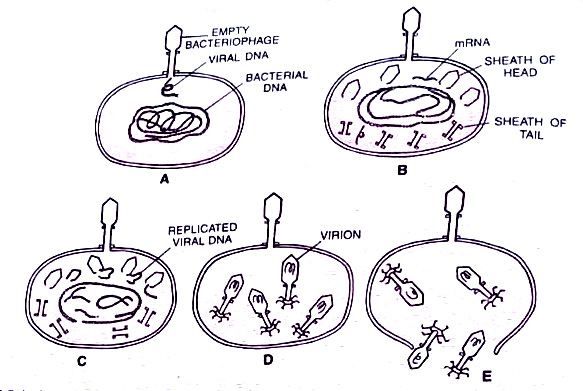
2. Lysogenic Cycle. Lambda phage (λ phage) has a higher degree of regulation of its genes. The phage is parasitic over Escherichia coli. It does not possess tail fibres for attachment to bacterial cell. The tail directly comes in contact with bacterial cell, drills a hole in the wall and injects the phage DNA into the cell. In lysogenic cycle, the phage DNA does not take over the control of cellular machinery of the host.
Instead, it produces a repressor (e.g., cl) and undergoes reduction temperature or non-virulent state. With the help of enzyme integrase the viral genome becomes integrated with the chromosomal DNA of the bacterium at a specific site (e.g., galactose locus in λ phase). In this form the viral genome is called prophage. (Biological Classification of Living Organisms Notes Study Material)

Prophage replicates along with bacterial chromosome and, therefore, gets distributed to the daughter bacteria. Prophage does not form virus particles because the genes connected with taking over of host machinery remain repressed due to formation of a repressor.
At times the synthesis of repressor is stopped. Repressor can also be destroyed by chemicals, high energy radiations and other adverse conditions. This converts the temperate or non-virulent virus into virulent or lytic virus. Therefore, the bacterial cell carrying prophage is called Iysogenic cell and the phenomenon of existence of virus genome in prophage state alongwith host DNA is termed as Iysogeny.
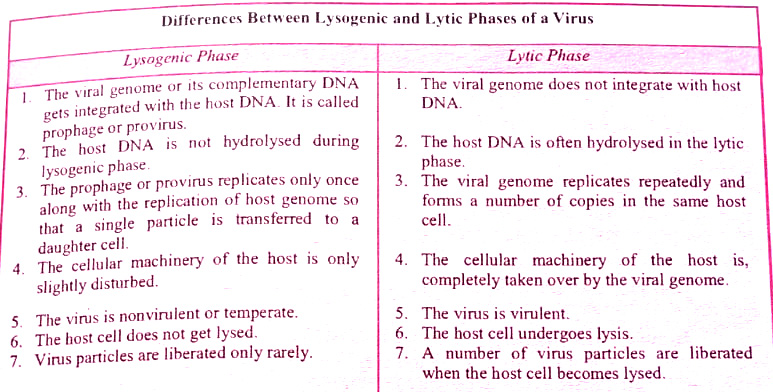
Viruses are intermediate between living and nonliving entities. They resemble non-living objects in-
(1) Lacking protoplast. (2) Ability to get crystallized, e.g., TMV, poliomyelitis virus. (3) Inability to live independent of a living cell. (4) High specific gravity which is found only in non-living objects. (5) Absence of respiration. (6) Absence of energy storing system. (7) Absence of growth and division. Instead different parts are synthesised separately. (Biological Classification of Living Organisms Notes Study Material)
Viruses resemble living beings in-
(1) Being formed of organic macromolecules which occur only in living beings.
(2) Presence of genetic material.
(3) Ability to multiply or reproduce.
(4) Occurrence of mutations. The most mutable virus is HIV or AIDS (Acquired Immune Deficiency Syndrome) virus followed by Influenza virus.
(5) Occurrence of enzyme transcriptase in most viruses.
(6) Some viruses like Pox virus contains vitamins like Riboflavin and Biotin.
(7) Occurrence of antigenic properties.
(8) Infectivity and host specificity.
(9) Viruses are ‘killed by autoclaving and ultraviolet x-rays.
(10) They breed true to their type. Even variations are inheritable.
(11) They take over biosynthetic machinery of the host cell and produce chemicals required for their multiplication.
(12) Viruses are responsible for a number of infectious diseases like common cold, epidemic influenza, chicken pox, mumps, poliomyelitis, rabies, herpes, AIDS, etc. (Biological Classification of Living Organisms Notes Study Material)
Viroids (L. virus-poison, eidos-diminutive)
They are the smallest self replicating particles which were discovered by Diener (1971). Viroids are infectious RNA particles which are devoid of protein coat. They are obligate of parasites. Molecular weight of a viroid is low. The RNA is tightly folded to form circular or linear structure.
Viroids are known to cause diseases (some 20) in plants only, e.g., Potato spindle tuber, chrysanthemum stunt. Animal or human infection is not known. Viroid does not produce a protein as it does not possess an initiation codon. The mechanism of disease production is not very clear. Viroid particle can multiply by both RNA dependent and DNA dependent replication. (Biological Classification of Living Organisms Notes Study Material)
Viral Diseases
- Plant Viral Diseases. Potato mosaic, Pumpkin mosaic, Apple mosaic, Tulip mosaic (Broken Tulip), Bhindi yellow vein mosaic, Potato Leaf roll, Papaya leaf curl, Banana bunchy top, Tomato bunchy, Rice tungro. (Biological Classification of Living Organisms Notes Study Material)
- Animal Viral Diseases. Foot and mouth, rinderpest, Ranikhet or new castle of fowl, bird flu.
- Human Viral Diseases. Measles, chickenpox, mumps, poliomyelitis, rabies, hepatitis, dengue, encephalilis, AIDS, common cold, flu, herpes, SARS (severe acute respiratory syndrome), bird flu (H5N1), Swine flu (H1N1).
PRIONS (Prusiner, 1983)
They are highly resistant glycoprotein particles which function as infectious agents. They are formed due to mutation in gene PRNP. Prions can also act as catalyst converting normal protein into prion state. Prions are not affected by proteases, nucleases, temperature upto 800°C, UV radiations and formaldehyde. (Biological Classification of Living Organisms Notes Study Material)
Prions accumulate in nervous tissue and bring about its degeneration. Common diseases caused by them are scrapie of sheep, mad cow disease, Cruetzfeldt-Jakob disease (CJD) and kuru.